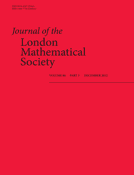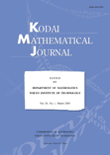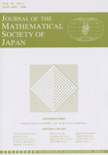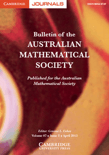
JOURNAL OF THE LONDON MATHEMATICAL SOCIETY-SECOND SERIES
Scope & Guideline
Shaping the Future of Mathematics with Every Publication
Introduction
Aims and Scopes
- Algebra and Number Theory:
Research articles in this area cover topics such as algebraic structures, number theory, and their applications. The journal publishes work that explores both theoretical aspects and computational techniques. - Geometry and Topology:
This encompasses a wide range of studies related to geometric structures, topological spaces, and their properties. The journal features articles that advance the understanding of geometric and topological methods in various contexts. - Analysis and Partial Differential Equations (PDEs):
Many papers focus on real and complex analysis, functional analysis, and the theory of partial differential equations. The journal seeks to publish innovative approaches to solving complex analytical problems. - Combinatorics and Graph Theory:
This area includes research on combinatorial structures, graph theory, and their applications in various fields. The journal aims to highlight new results and techniques in combinatorial mathematics. - Mathematical Physics:
The intersection of mathematics and physics is explored through studies on mathematical models in physics. The journal publishes articles that provide mathematical foundations for physical theories. - Mathematical Logic and Foundations:
This includes research on the foundations of mathematics, model theory, set theory, and other areas of logic. The journal encourages submissions that address foundational issues and logical frameworks.
Trending and Emerging
- Nonlinear Dynamics and Differential Equations:
There has been a notable increase in research focused on nonlinear differential equations and dynamical systems. This reflects a growing interest in understanding complex systems and their behaviors, particularly in applied mathematics. - Algebraic Geometry and Its Applications:
The trend towards algebraic geometry, especially in relation to computational and categorical aspects, has become more prominent. Researchers are exploring connections between algebraic geometry and other fields, such as physics and number theory. - Geometric Analysis:
This emerging scope includes the study of differential geometry in relation to analysis, particularly in the context of geometric flows and curvature properties. The interconnection between geometry and analysis is increasingly highlighted in recent publications. - Topological Data Analysis:
The rise of data science has led to an increased focus on topological methods for data analysis. Researchers are employing techniques from algebraic topology to derive insights from complex datasets, showcasing the practical applications of mathematical theories. - Higher Category Theory and Homotopy Theory:
The exploration of higher category theory and its implications for homotopy theory is gaining momentum. This reflects a broader trend towards understanding complex algebraic structures and their relationships in advanced mathematics.
Declining or Waning
- Classical Geometry:
While still relevant, classical geometry has seen a decrease in publication frequency as researchers increasingly focus on more abstract and modern geometric concepts. Works on traditional geometric constructions and properties are becoming less common. - Elementary Number Theory:
The focus on elementary approaches to number theory is diminishing as the field shifts toward more advanced and computationally intensive methods. Papers that deal with classical number-theoretic problems without computational applications are less frequently submitted. - Commutative Algebra:
Although foundational, the area of commutative algebra appears to be receiving less attention in recent years, with fewer papers addressing classical topics. Researchers seem to be gravitating toward more specialized or applied aspects of algebra. - Basic Topology:
Basic topology, particularly introductory or elementary papers, has seen a decline as the journal's scope embraces more complex and abstract topological concepts. There is a noticeable shift towards advanced topology and its applications.
Similar Journals

COLLOQUIUM MATHEMATICUM
Exploring the depths of mathematics for a global audience.COLLOQUIUM MATHEMATICUM, published by ARS POLONA-RUCH, serves as an essential platform for the dissemination of innovative research in the field of mathematics. With an ISSN of 0010-1354 and a dedicated E-ISSN of 1730-6302, this journal plays a crucial role in advancing mathematical knowledge and fostering collaboration within the academic community. Although it is categorized in the Q3 quartile for miscellaneous mathematics, its content consistently attracts a diverse readership, reflecting a wide array of mathematical disciplines. Spanning publication years from 2001 to 2009 and resuming from 2011 to the present, *COLLOQUIUM MATHEMATICUM* offers researchers, professionals, and students the unique opportunity to engage with groundbreaking concepts and methodologies. With its home base in Warsaw, Poland, this journal not only contributes to the regional mathematical landscape but also impacts the broader global community. While currently not adopting an open access model, the journal remains committed to quality research, evidenced by its Scopus ranking within the general mathematics category. Engage with *COLLOQUIUM MATHEMATICUM* to be at the forefront of mathematical exploration.

Kodai Mathematical Journal
Advancing Mathematical Frontiers Since 1949Kodai Mathematical Journal is a distinguished publication dedicated to advancing the field of mathematics, particularly in miscellaneous areas. Established in 1949, this esteemed journal has been a reputable source for researchers and practitioners who seek to contribute to the rich landscape of mathematical knowledge. Published by KINOKUNIYA CO LTD, the journal is based in the academic environment of Tokyo Institute of Technology and serves a global audience with rigorous and insightful research articles. Despite its current Q3 quartile ranking in the Scopus Mathematics category, which reflects its niche but impactful contributions, the journal is poised for growth; the convergence of traditional and novel mathematical techniques promises to enhance its relevance further. Researchers, professionals, and students are encouraged to engage with the rich content of the journal, aimed at fostering collaboration and nurturing innovation in the mathematical community. While currently not available as Open Access, Kodai Mathematical Journal remains a critical resource for those passionate about mathematics and its applications.

JOURNAL OF THE MATHEMATICAL SOCIETY OF JAPAN
Unveiling New Frontiers in Mathematical ResearchJournal of the Mathematical Society of Japan, established in 1948, is a premier scholarly journal dedicated to advancing mathematical research and discourse. Published by the esteemed Mathematical Society of Japan, this journal has consistently achieved recognition for its rigorous and innovative contributions to the field, achieving a prestigious Q1 category ranking in miscellaneous mathematics as of 2023. Although it maintains a subscription-based access model, the journal remains an invaluable resource for researchers, professionals, and students alike, fostering a deeper understanding and exploration of mathematics across various disciplines. With a focus on disseminating high-quality original research, reviews, and comprehensive articles, the Journal of the Mathematical Society of Japan plays a crucial role in the global mathematical community and continues to influence new generations of mathematicians through its commitment to excellence.

Portugaliae Mathematica
Fostering Collaboration in Mathematical InquiryPortugaliae Mathematica is a distinguished open-access journal published by the European Mathematical Society (EMS), dedicated to the field of mathematics. With its ISSN 0032-5155 and E-ISSN 1662-2758, this journal aims to disseminate high-quality research papers, reviews, and notable contributions in various domains of mathematics. Located in Germany, it has been actively publishing since 2011 and operates under the address Publishing House GmbH, Inst Mathematik, Technische Universität Berlin, Straße 17, Juni 136, Berlin 10623, Germany. The journal has embraced an open-access model since 2022, enhancing the accessibility of mathematical research to a global audience. With a current Scopus rank placing it in the 29th percentile in the miscellaneous mathematics category, it provides a platform for both emerging and well-established researchers to share their findings. Despite its Q4 ranking, the journal plays a crucial role in fostering mathematical inquiry and collaboration. Researchers, professionals, and students alike will find Portugaliae Mathematica an invaluable resource for enriching their expertise and staying abreast of developments in the mathematical sciences.

Bulletin of the Iranian Mathematical Society
Elevating the discourse in mathematics, one article at a time.The Bulletin of the Iranian Mathematical Society, published by SPRINGER SINGAPORE PTE LTD, is a distinguished journal dedicated to advancing the field of mathematics. With an ISSN of 1017-060X and E-ISSN 1735-8515, this journal has established a valuable platform for researchers and scholars to disseminate their findings from 2008 to 2024. The journal is categorized in the Q2 tier of Mathematics (miscellaneous) for 2023, showcasing its importance and relevance in the mathematical community, ranked #169 out of 399 in General Mathematics with a 57th percentile standing in Scopus. While currently operating under a subscription model, it remains an essential resource for professionals and students seeking cutting-edge research and developments in various domains of mathematics. The Bulletin aims to bridge theoretical research and practical application, thereby enriching both academia and industry.

BULLETIN OF THE AUSTRALIAN MATHEMATICAL SOCIETY
Fostering Scholarly Dialogue in MathematicsBULLETIN OF THE AUSTRALIAN MATHEMATICAL SOCIETY is an esteemed journal dedicated to advancing the field of mathematics, published by Cambridge University Press. Since its inception in 1969, this periodical has fostered scholarly communication and showcased pivotal research in various domains of mathematics, now projected to continue until 2024. With an impact factor that places it in the Q2 category of miscellaneous mathematics research, it holds a notable position among its peers, ranking 215th out of 399 in the Scopus database. Though it does not currently offer open access options, the journal remains a vital resource for researchers, professionals, and students seeking to deepen their understanding of mathematical advancements. The Bulletin serves as a crucial platform for disseminating original research, comprehensive reviews, and insightful perspectives that navigate the complexities of mathematics today, ensuring the community is well-informed and engaged.

ANNALES DE L INSTITUT FOURIER
Championing Rigorous Research and CollaborationANNALES DE L INSTITUT FOURIER is a premier academic journal published by ANNALES INST FOURIER, specializing in the fields of Algebra and Number Theory as well as Geometry and Topology. Since its establishment, the journal has garnered a distinguished reputation, evidenced by its Q1 quartile ranking in the 2023 category assessments and its Scopus Rank of #37 out of 119 in Algebra and Number Theory, and #34 out of 106 in Geometry and Topology, placing it within the top percentile of its field. The journal serves as a vital platform for disseminating groundbreaking research and innovative methodologies, catering to a global audience of researchers, professionals, and students. With a commitment to the advancement of mathematical sciences, ANNALES DE L INSTITUT FOURIER invites contributions that push the boundaries of knowledge and foster collaboration across disciplines. Although it does not offer open access, the rigorous peer-review process ensures that published papers meet the highest academic standards, making it a critical resource for anyone engaged in advanced mathematical research.

PUBLICATIONES MATHEMATICAE DEBRECEN
Cultivating a Global Community of Mathematical ScholarsPublicationes Mathematicae Debrecen is a renowned international journal published by the University of Debrecen, Institute of Mathematics, situated in Hungary. This journal, with both ISSN 0033-3883 and E-ISSN 2064-2849, has established itself in the field of mathematics since its inception, with coverage extending from 1997 to 2024. Recognized for its rigorous academic standards, it currently holds a Q3 ranking in the mathematics (miscellaneous) category for 2023 and ranks at the 42nd percentile among general mathematics journals in Scopus. Publicationes Mathematicae Debrecen aims to disseminate high-quality research across various areas of mathematics, contributing to the advancement of knowledge and practice in this dynamic field. Although it is not an open-access journal, its readers can access a wealth of scholarly work that addresses both theoretical and applied mathematical issues, making it an invaluable resource for researchers, professionals, and students alike.

Mediterranean Journal of Mathematics
Empowering the Next Generation of MathematiciansThe Mediterranean Journal of Mathematics, published by SPRINGER BASEL AG, is a prominent platform dedicated to the advancement of mathematical research and education. Since its inception in 2004, this journal has been pivotal in disseminating high-quality research across various fields of mathematics, currently holding a notable Q2 ranking in the miscellaneous mathematics category as of 2023. With its ISSN 1660-5446 and E-ISSN 1660-5454, the journal enjoys a respected position in the academic community, evident by its Scopus rank of 129 out of 399 in General Mathematics, placing it in the 67th percentile. While primarily a subscription-based journal, it remains committed to providing a comprehensive resource for researchers, professionals, and students, fostering dialogue and exploration within the mathematical sciences. The Mediterranean Journal of Mathematics, based in Basel, Switzerland, continues to contribute significantly to the evolution of mathematical theory and practice, marking its relevance as we approach its 20th anniversary in 2024.

Hiroshima Mathematical Journal
Connecting Researchers Through Innovative Mathematical InsightsThe Hiroshima Mathematical Journal, published by Hiroshima University, Graduate School of Science, serves as a prominent platform for disseminating high-quality research in the field of mathematics. Established in 1959, the journal has been an integral part of the mathematical community, focusing on areas such as Algebra, Number Theory, Analysis, and Geometry and Topology. Although currently classified in Q4 quartile rankings within its categories, the journal is committed to advancing mathematical knowledge and fostering scholarly dialogue. Its accessibility, combined with its long-standing history, makes it an essential resource for researchers, professionals, and students dedicated to exploring and enhancing the mathematical sciences. For those interested in contributing or accessing cutting-edge research, the Hiroshima Mathematical Journal continues to uphold its mission of excellence in mathematical scholarship.